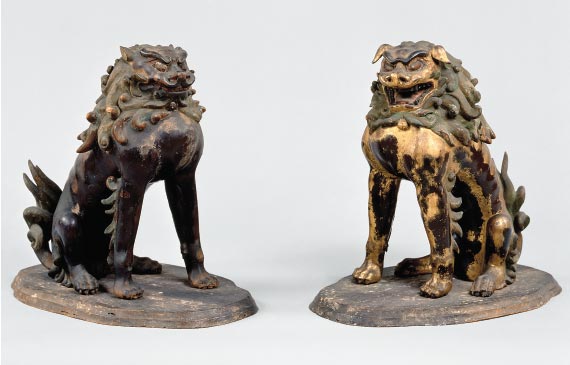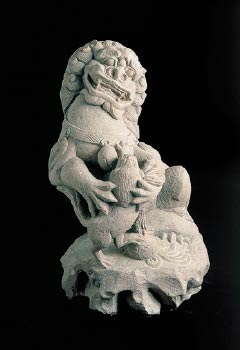

A stunning shishi (designated Important Cultural Properties), dated
to the mid to latter part of the Heian period, from the renowned
Nara temple Yakushi-ji were carved in 1087 and represent an
exquisite and elegant pair from an age when the imperial court ruled
Japan. One of two pairs, recently designated Important Cultural
Properties, from Takano Shrine in Tsuyama City, Okayama Prefecture,
expresses humor and an expansive quality in workmanship, and
exhibits a quiet elegance that is stylistically reminiscent of the
masterful Buddhist sculptures of Jōchō. Several outstanding examples
can be found in the San’yōdō region, one of them being a bold pair
(designated Important Cultural Properties) from Mitsuki Hachiman
Shrine in Mihara City, Hiroshima Prefecture. The shrine has also
loaned an enormous lion mask (also designated Important Cultural
Property) for this exhibit. Several dynamic works that went to
overseas collections will also be in this exhibition.
Muscular, powerful-looking works were carved in the Kamakura period. A well-known example is the komainu of Nagataki Shrine in Okumino, which is associated with the sacred mountain range Hakusan. Several excellent guardian statues can be found in Shiga Prefecture, though the Important Cultural Property-designated pair belonging to Daihō Shrine in Rittō City is perhaps among the highest in finished form. These noble and powerful creatures greatly surpass the realm of mere guardians. Shina Shrine in Kusatsu City, a major Tendai temple Kongōrin-ji, and Shirahige Shrine in Nagahama City (all in Shiga Prefecture) also have superb komainu from the Kamakura to Nanbokuchō (1336– 1392) period. Also of great interest is a shishi from Kumano Shrine in Akaiwa City, Okayama Prefeture, that appears stylistically unlike its Japanese counterparts. Perhaps the many cultural objects introduced to Japan through trade with Song-dynasty China during the Kamakura period and the association that this shrine purportedly had with the monk Shunjō-bō Chōgen (1121–1206), who was instrumental in the reconstruction of the great monastery Tōdai-ji in Nara, may have had something to do with this work.
Muscular, powerful-looking works were carved in the Kamakura period. A well-known example is the komainu of Nagataki Shrine in Okumino, which is associated with the sacred mountain range Hakusan. Several excellent guardian statues can be found in Shiga Prefecture, though the Important Cultural Property-designated pair belonging to Daihō Shrine in Rittō City is perhaps among the highest in finished form. These noble and powerful creatures greatly surpass the realm of mere guardians. Shina Shrine in Kusatsu City, a major Tendai temple Kongōrin-ji, and Shirahige Shrine in Nagahama City (all in Shiga Prefecture) also have superb komainu from the Kamakura to Nanbokuchō (1336– 1392) period. Also of great interest is a shishi from Kumano Shrine in Akaiwa City, Okayama Prefeture, that appears stylistically unlike its Japanese counterparts. Perhaps the many cultural objects introduced to Japan through trade with Song-dynasty China during the Kamakura period and the association that this shrine purportedly had with the monk Shunjō-bō Chōgen (1121–1206), who was instrumental in the reconstruction of the great monastery Tōdai-ji in Nara, may have had something to do with this work.
As time progressed from the Muromachi period (1333–1573) to the
Momoyama (1573–1615), though maintaining tradition, distinctive
komainu in each region appeared. In ceramic-producing village of
Seto, earthenware komainu were made, while relatively plain stone
examples also emerged. Another interesting and rare komainu is made
of bronze and is scribed with the name Mogami Yoshiaki (1546–1614),
who is remembered as a cruel and scheming warlord. The idiosyncratic
komainu that were carved by the sculptor Enkū (1632–1695), who
wandered all over Japan creating many interesting carvings, in the
Edo period (1615–1868), and that are enshrined in Kōga Shrine in
Gifu Prefecture, continue to attract deep devotion to this day.
While being rotated due to conservation purposes, the very few valuable shishi and komainu, which have been introduced here, will come together at the MIHO MUSEUM. These sacred animals, which came from the distant Eurasian continent to Japan, have taken on a unique role and even now are cherished by the Japanese.
While being rotated due to conservation purposes, the very few valuable shishi and komainu, which have been introduced here, will come together at the MIHO MUSEUM. These sacred animals, which came from the distant Eurasian continent to Japan, have taken on a unique role and even now are cherished by the Japanese.

